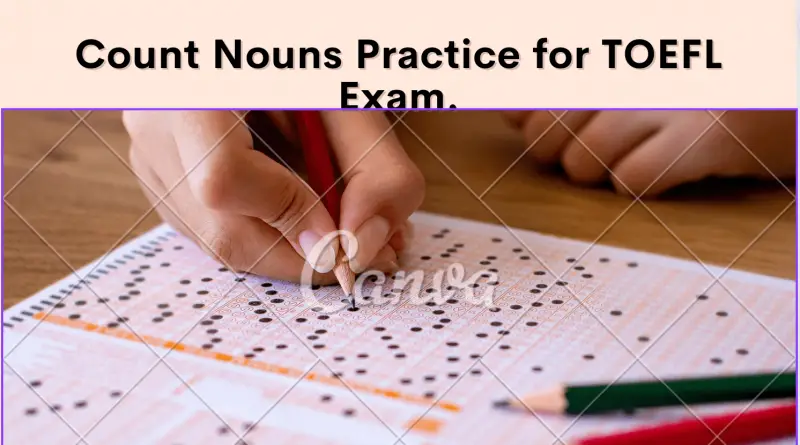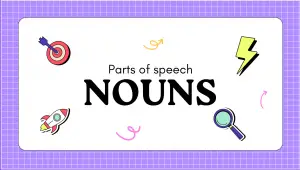TOEFL Count Nouns Practice – Part 1
TOEFL Count Nouns Practice – Part 1
#1. Select the count noun from the options below.
Answer : d) Apple
“Apple” is a count noun because it refers to an item that can be counted individually (e.g., one apple, two apples). This characteristic of being able to exist in singular and plural forms and to be quantified directly distinguishes count nouns from non-count nouns, which cannot be counted in this manner.
#2. Choose the non-count noun from the list.
Answer : c) Coffee
“Coffee” can refer to either the beverage or the ground beans used to make it, both of which are treated as non-count nouns because they are not quantified in individual units without a measure of volume or weight. This highlights the nature of non-count nouns to encompass substances or materials that are seen as an undivided whole in terms of quantification.
#3. Which option correctly uses a count noun?
Answer : b) Many chairs
“Many” is used with count nouns to indicate a large quantity.
The word “many” is used with count nouns to indicate a large but unspecified quantity, which fits the nature of “chairs” as they can be individually counted. This contrasts with expressions like “much” used for non-count nouns, where the quantity cannot be individually itemized.
#4. Which option is a non-count noun?
Answer : b) Happiness
“Happiness” is a non-count noun because it refers to an abstract concept or state of being that cannot be quantified or counted individually. Non-count nouns often represent abstract concepts, qualities, or states rather than tangible objects, which do not have a plural form and are not used with indefinite articles (a, an).
#5. Identify the non-count noun in the sentence: “She has a lot of knowledge about history.”
Answer : b) Knowledge
“Knowledge” is a non-count noun because it refers to an unquantifiable amount of information.
“Knowledge” is considered a non-count noun because it refers to an abstract concept that cannot be divided into individual elements or counted. In this context, “knowledge” encompasses a broad understanding or awareness of history, which cannot be quantified with numbers, highlighting the nature of non-count nouns as encompassing ideas, qualities, or states rather than discrete objects.
#6. Identify the count noun in the sentence: “There are three books on the table.”
Answer : b) Books
“Books” is the count noun in this sentence because it is being quantified by the number “three,” indicating that it can be counted individually. This demonstrates the characteristic of count nouns to have singular and plural forms and to be used with numbers or quantifiers that indicate specific quantities.
#7. Which sentence correctly uses a count noun?
Answer : b) He bought a few eggs from the market.
“Eggs” are countable, so “a few” is the correct quantifier to use.
“Eggs” are countable items, making them count nouns. The quantifier “a few” is used with count nouns to indicate a small, specific number of items. This sentence correctly matches the quantifier with the type of noun, illustrating how count nouns can be quantified and referred to in terms of specific numbers or amounts.
#8. Choose the non-count noun from the list below.
Answer : c) Music
Music cannot be counted with numbers and does not take a plural form, making it a non-count noun.
Music refers to a general concept or collection of sounds and cannot be counted with numbers. Unlike count nouns, it does not have a plural form and is treated as a singular entity, illustrating the nature of non-count nouns which encompass substances, concepts, or collective categories of things.
#9. Which of the following is a count noun?
Answer : d) Dog
Dogs can be counted, so “dog” is a count noun.
“Dog” is a count noun because it refers to a tangible object that can be counted (e.g., one dog, two dogs). Count nouns have both singular and plural forms and can be used with numbers or quantifiers like “many” or “a few,” which is not applicable to non-count nouns that represent general substances, concepts, or masses of material without distinct boundaries.
#10. Choose the correct sentence with a non-count noun.
Answer : b) He has a lot of money.
“Money” is a non-count noun, and “a lot of” is correctly used to indicate quantity.
“Money” is a non-count noun because it represents a concept of currency that is not counted in individual units (like coins or bills) in this context but rather as an abstract sum. The phrase “a lot of” is suitable for both count and non-count nouns but is used here to indicate a large quantity of something that is not individually counted, showcasing the flexibility in expressing quantities of non-count nouns.
#11. Select the count noun from the options below.
Answer : d) Tree
“Tree” is a count noun because it refers to an object that can be counted individually (e.g., one tree, two trees). Count nouns can be identified by their ability to take a plural form and to be quantified with numbers or quantifiers like “many” or “a few.”
#12. Which sentence correctly uses a non-count noun?
Answer : c) He added too much salt to the recipe.
“Salt” is a non-count noun because it refers to a substance that is not counted in individual units. The quantifier “too much” is appropriately used with non-count nouns to indicate an excessive quantity, highlighting how non-count nouns are used to describe substances or materials without distinct boundaries.
#13. Select the sentence that correctly uses a non-count noun.
Answer : c) There is a little water in the bottle.
“Water” is a non-count noun, and “a little” is correctly used to indicate a small amount.
“Water” is a non-count noun because it refers to a substance that cannot be counted in individual units without a measure of volume. The phrase “a little” is appropriately used with non-count nouns to indicate a small quantity, emphasizing the nature of non-count nouns to describe things that are not easily quantifiable in discrete units.
#14. Which sentence correctly uses a non-count noun?
Answer : b) There is a little milk left in the fridge.
“Milk” is a non-count noun because it refers to a liquid substance that is not counted in individual units. The phrase “a little” is appropriately used with non-count nouns to indicate a small quantity, emphasizing the nature of non-count nouns to describe things that are not easily quantifiable in discrete units.
#15. Which option correctly uses a count noun?
Answer : c) I bought a few chairs for the dining room.
“Chairs” are countable items, making them count nouns. The quantifier “a few” is correctly used with count nouns to indicate a small, specific number of items. This sentence accurately matches the quantifier with the type of noun, illustrating the direct quantification possible with count nouns.
#16. Identify the non-count noun in the options below.
Answer : b) Water
“Water” is a non-count noun because it refers to a substance that cannot be counted in individual units without a measure of volume. Non-count nouns like water are often substances or materials that are treated as an undivided whole when it comes to quantification, requiring units of measurement for specific quantities.
#17. Which option is a non-count noun?
Answer : c) Sand
Sand cannot be counted in individual units without a container, making it a non-count noun.
“Sand” is a non-count noun because it refers to a substance made up of fine grains that are not counted individually in ordinary contexts. Non-count nouns like sand are often substances or materials that, due to their nature, are treated as an undivided whole when it comes to quantification, requiring units of measurement for specific quantities.
#18. Identify the count noun in the following list.
Answer : d) Car
Cars can be counted, making “car” a count noun.
“Car” is a count noun because it refers to an item that can be counted individually (e.g., one car, two cars). This characteristic of being able to exist in singular and plural forms and to be quantified directly is what distinguishes count nouns from non-count nouns, which cannot be counted in this manner.
#19. Which of the following is a count noun?
Answer : c) Apple
Apples can be counted individually, making “apple” a count noun.
An apple can be counted as one apple, two apples, etc., demonstrating the characteristic of count nouns to have singular and plural forms. This is unlike non-count nouns, which cannot be easily quantified without a unit of measure.
#20. Which noun is typically considered a non-count noun?
Answer : a) Idea
“Idea” is a non-count noun because it refers to a concept or thought that cannot be quantified or counted individually. Non-count nouns often represent abstract concepts, substances, or collective categories of items, which do not have a plural form and are not used with indefinite articles (a, an).
Results
TOEFL Count Nouns Practice – Part 1
TOEFL Count Nouns
Dive into Part 1 of our TOEFL count nouns practice for a higher score. Perfect your grammar skills.
TOEFL Count Nouns Practice – Part 1
TOEFL Count Nouns
Dive into Part 1 of our TOEFL count nouns practice for a higher score. Perfect your grammar skills
HD Quiz powered by harmonic design
TOEFL Count Nouns Practice – Part 1
TOEFL Count Nouns
Dive into Part 1 of our TOEFL count nouns practice for a higher score. Perfect your grammar skills
Dive into Part 1 of our TOEFL count nouns practice for a higher score. Perfect your grammar skills
Dive into Part 1 of our TOEFL count nouns practice for a higher score. Perfect your grammar skills |





